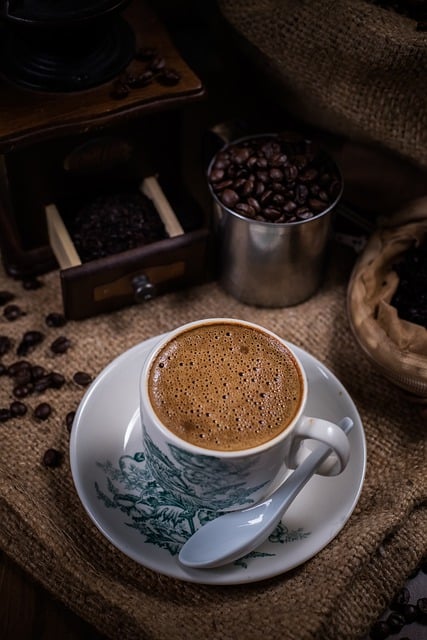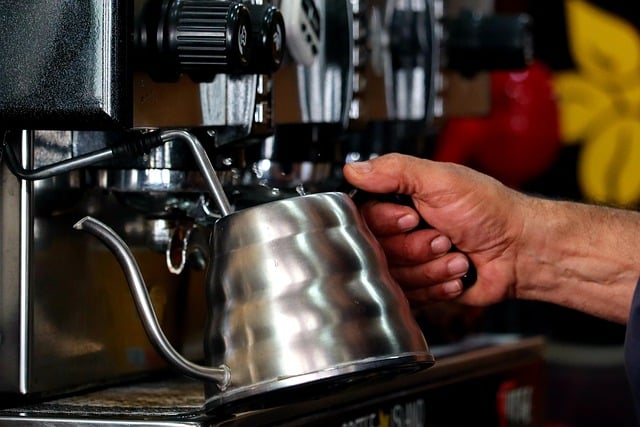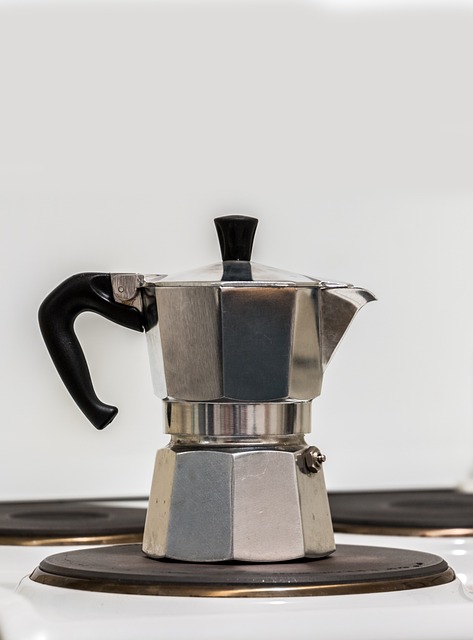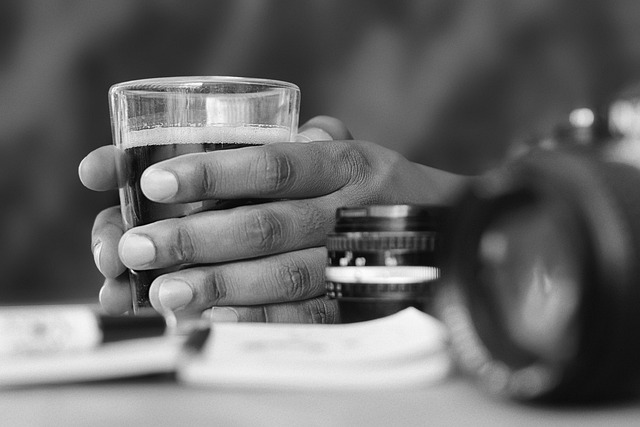Mastering Home Coffee Craft: A Brewer’s Guide to Methods, Pour-Overs, and Espresso
This section covers various coffee brewing techniques including French Press, pour-over (V60, AeroP…….

This section covers various coffee brewing techniques including French Press, pour-over (V60, AeroPress), espresso, cold brew, and iced coffee, each with its own specific grind size, water temperature, and timing requirements. The French Press method uses a medium grind and optimal water temperature, while pour-over offers precise control over extraction. Espresso demands exacting techniques and knowledge of the coffee's origin and roast profile. Cold brew involves steeping coarsely ground beans in cool water for hours to achieve a sweeter, less acidic taste. Iced coffee is made by hot-brewing coffee and cooling it over ice, resulting in a stronger flavor. Mastering these methods at home elevates the coffee experience, allowing for personalized and creative coffee enjoyment. Cold brew and iced coffee offer distinct flavors due to their different preparation processes. Home cold brew requires steeping coarsely ground beans in water for 12-24 hours before filtering, while iced coffee is made by immediately cooling hot brewed coffee over ice. Mastery of home espresso involves a precise interplay of grind size, dosing, temperature, pressure, and timing, with attention to the coffee's consistency, the tamping of grounds, and the espresso's color, flow, and crema, all of which contribute to the perfect cup.
discovery of coffee’s transformative effects on well-being has sparked a global fascination with brewing methods. From the rich, full-bodied extraction of a French Press to the delicate art of pour-over coffee, each technique not only offers a unique flavor profile but also its own set of health advantages. This comprehensive guide delves into the world of coffee brewing, unveiling the intricacies and benefits of various methods. Whether you’re a novice home barista or an enthusiast seeking to enhance your coffee craft, this article provides a robust foundation to master each technique, from cold brew to espresso, ensuring you unlock the full spectrum of coffee’s healthful offerings and savor a perfect cup every time. Join us as we explore the artistry and science behind home coffee brewing, transforming your kitchen into a café of excellence.
- Mastering Coffee Brewing Methods: A Comprehensive Overview
- The Definitive Guide to Home Pour-Over Coffee Perfection
- Cold Brew vs. Iced Coffee: Understanding the Differences and Crafting Both at Home
- Espresso Fundamentals for the Home Barista: Achieving the Perfect Shot
Mastering Coffee Brewing Methods: A Comprehensive Overview

Mastering coffee brewing methods is an art that transforms the simplicity of ground beans into a symphony of aromas and flavors. Each brewing technique offers a distinct profile, from the robust and full-bodied extraction of a French Press to the delicate and nuanced flavors of a pour-over. Understanding the science behind these methods, including grind size, water temperature, and brewing time, is crucial for bringing out the best in your coffee. The French Press method, for instance, requires a medium grind and a water temperature between 195°F and 205°F (90°C to 96°C) to achieve a balanced cup. Meanwhile, pour-over techniques, such as the V60 or AeroPress, allow for greater control over extraction, offering a lighter and more refined taste.
Advancing to espresso brewing, one must focus on fine-ground coffee and higher water pressure to produce that rich, concentrated shot. Espresso machines come in various forms, from manual lever machines to automatic super-automatic models, each with its own set of idiosyncrasies and techniques for perfecting the art of pulling a shot. Mastery here involves precise tamping, grinding, dosing, and timing, as well as an understanding of the coffee’s origin and roast profile to tailor the extraction to your palate. Cold brew and iced coffee, while sometimes used interchangeably, are distinct processes: cold brew involves a longer steep time at room temperature or in a refrigerator, resulting in a sweet and less acidic brew, while iced coffee is hot-brewed and then cooled over ice, often leading to a stronger, more bitter flavor. Exploring these diverse methods not only elevates your home coffee experience but also opens up a world of possibilities for personalization and creativity in your daily cup.
The Definitive Guide to Home Pour-Over Coffee Perfection

Mastering home pour-over coffee brewing is an art form that combines precision, patience, and a keen sense of taste to yield a perfect cup every time. The pour-over method, characterized by its delicate filtration and controlled extraction, allows for a nuanced expression of the coffee’s flavors. To achieve perfection, start with fresh, finely ground beans appropriate for your desired brewing ratio—a general guideline is a 1:15 to 1:17 coffee-to-water ratio. Before brewing, preheat your pour-over equipment (including the kettle and carafe) to maintain temperature consistency throughout the process.
Begin by placing a filter in your pour-over cone and rinsing it with hot water to eliminate any papery taste and to warm up the server. Next, gently pour a small amount of water over the coffee grounds, just enough to saturate them completely and allow them to ‘bloom’ for about 30 seconds. This step helps release carbon dioxide and ensures a more even extraction. Continue pouring the remaining water in a slow, circular motion, starting from the center and moving outward, ensuring that the water comes into contact with all grounds without overwhelming any one area. The goal is to achieve a balanced extraction, where all the coffee’s flavors—from bright and fruity to deep and chocolatey notes—are brought to the forefront. Always monitor the brew’s progress, adjusting your pour as needed based on how quickly the water is being absorbed. With practice and attention to detail, you’ll unlock the secrets to consistently producing a cup that rivals any barista’s best efforts, all from the comfort of your home.
Cold Brew vs. Iced Coffee: Understanding the Differences and Crafting Both at Home

Cold brew coffee and iced coffee, often confused, are two distinct brewing methods that yield different flavor profiles and experiences. Cold brew is a slow extraction process that involves steeping coarsely ground coffee beans in room temperature or chilled water for an extended period, typically between 12 and 24 hours. This prolonged contact time results in a beverage with lower acidity levels and a smoother taste, characterized by its rich, chocolatey, and wine-like characteristics. In contrast, iced coffee is simply hot-brewed coffee that is cooled over ice. It’s typically brewed using the same methods as regular hot coffee but is poured over ice to serve. This rapid chilling process can result in a more bitter and acidic flavor due to the quick extraction of compounds from the coffee grounds.
To craft both cold brew and iced coffee at home, start by understanding the key differences between the two. For cold brew, you’ll need a large container, coarsely ground coffee (a medium-fine consistency works best), and time. A simple ratio to follow is one part coffee to four parts water. Place your grounds in the container, add the water, stir gently to saturate all the coffee, cover, and let it sit at room temperature or in the refrigerator for the desired duration. After the steeping period, filter out the grounds using a fine mesh strainer or a cold brew maker with a paper filter. For iced coffee, brew your favorite coffee using your preferred method—whether it’s a French press, pour-over, or drip machine—and then pour the hot coffee over ice immediately after brewing. Experiment with different grind sizes and coffee-to-water ratios to achieve your desired strength and flavor. With these methods, you can enjoy both the smooth, sweet complexity of cold brew and the refreshing sharpness of iced coffee right from your kitchen.
Espresso Fundamentals for the Home Barista: Achieving the Perfect Shot

mastering the art of espresso brewing at home requires an understanding of both the mechanics of the machine and the nuances of coffee itself. The quest for the perfect shot is a delicate balance between grind size, dosing, temperature, pressure, and timing. To begin, select high-quality, finely ground coffee beans suited to your espresso machine; the right bean is paramount. The grind should be fine but not too powdery; it should resemble the consistency of sea salt. Properly tamping the grounds is crucial to achieve an even extraction; the puck should be level and compact, with no gaps or channels that can hinder the flow of water through the coffee. Preheat your espresso machine to maintain optimal temperature for brewing, as cold equipment can result in over-extracted or sour coffee. When you’re ready to brew, start a timer as you initiate the extraction; a typical shot takes around 25 to 30 seconds. Monitor the color and flow of the espresso; it should be a rich, dark brown with a velvety crema on top. If the espresso flows too quickly or too slowly, adjust your grind size accordingly. The crema, a creamy layer on top of the shot, is indicative of proper extraction; it should be thick and light tan in color. Practice and patience are key to perfecting the espresso shot at home, transforming your kitchen into a personal coffee lab where you can experiment with different variables to craft your ideal cup. Remember, the journey to the perfect espresso is as much about technique as it is about savoring and enjoying the process and the results.
exploration into the world of coffee brewing, this guide has traversed a diverse array of techniques and recipes. From mastering the French Press to the nuances of pulling a perfect espresso shot at home, readers have been equipped with the knowledge to elevate their coffee experience. The clarity between cold brew and iced coffee has been demystified, offering a deeper appreciation for each method’s unique flavor profiles. Additionally, the array of recipes presented, from classic lattes to innovative brews, promises a journey of discovery for even the most seasoned coffee enthusiast. As you apply these methods and experiment with new flavors, remember that the ultimate goal is to find joy in the process and savor the taste of your personal coffee masterpiece. Happy brewing!







